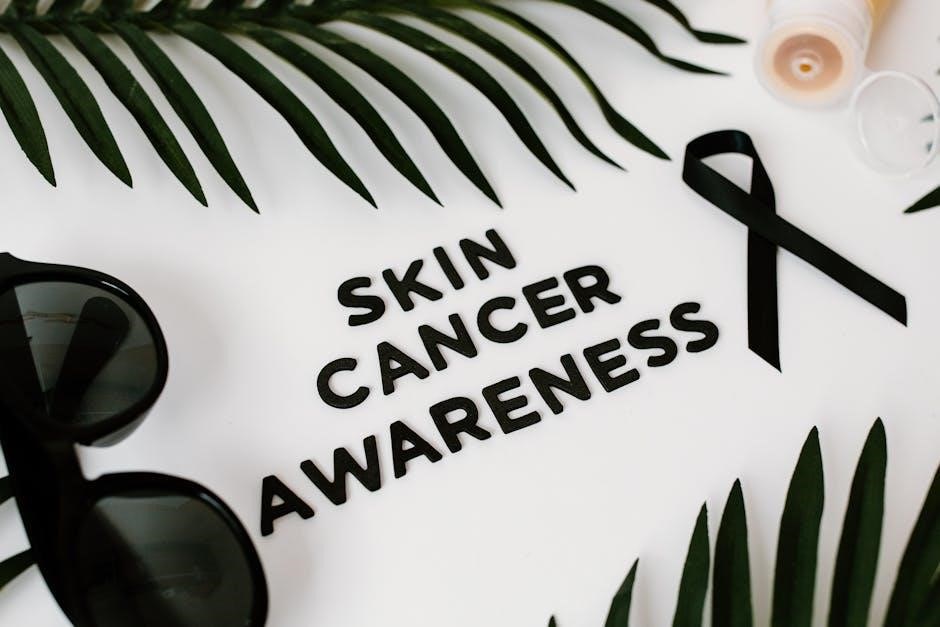Image-Guided Superficial Radiation Therapy (IGSRT) is a non-invasive, highly effective treatment for non-melanoma skin cancers, offering precise delivery of radiation using advanced imaging technology.
What is Image-Guided Superficial Radiation Therapy (IGSRT)?
Image-Guided Superficial Radiation Therapy (IGSRT) is a non-invasive treatment that uses advanced imaging to precisely deliver low-energy radiation to superficial skin cancers. It employs the FDA-cleared SRT-100 Vision device, combining ultrasound imaging for accurate targeting. This method ensures minimal damage to healthy tissue while effectively treating non-melanoma skin cancers, offering a surgery-free alternative with high efficacy and cosmetic appeal.
The Role of Imaging in Skin Cancer Treatment
Imaging plays a crucial role in IGSRT, enabling precise targeting of skin cancer lesions. Ultrasound technology is used to visualize the tumor’s depth and margins, ensuring accurate radiation delivery. This real-time guidance minimizes exposure to surrounding healthy tissue, enhancing treatment safety and effectiveness. Advanced imaging also aids in monitoring treatment response and adjusting dosages, making it integral to the success of Image-Guided Superficial Radiation Therapy in managing non-melanoma skin cancers effectively.

Advantages of Image-Guided SRT
Image-Guided SRT offers a non-invasive, surgery-free treatment with minimal downtime, providing precise targeting and high success rates for non-melanoma skin cancers, FDA-cleared for efficacy.
Non-Invasive and Surgery-Free Treatment
Image-Guided SRT is a non-invasive, surgery-free option for treating non-melanoma skin cancers, eliminating the need for incisions or sutures. This approach minimizes scarring and downtime, offering a gentle alternative to traditional surgical methods. With high efficacy rates exceeding 99%, IGSRT delivers precise radiation guided by imaging, targeting cancer cells while preserving surrounding healthy tissue. Patients benefit from a quick recovery and minimal complications, making it an appealing choice for those seeking a less intrusive treatment solution.
High Efficacy Rates for Non-Melanoma Skin Cancers
Image-Guided SRT demonstrates exceptional efficacy in treating non-melanoma skin cancers, with success rates surpassing 99%. This method is particularly effective for basal and squamous cell carcinomas, offering a high cure rate with minimal side effects. Clinical studies involving thousands of patients have consistently shown its effectiveness, making it a reliable treatment option for non-invasive skin cancer cases, providing long-term remission and reducing the risk of recurrence compared to other therapies.
Effectiveness of Image-Guided SRT
Image-Guided SRT is highly effective for basal and squamous cell carcinomas, offering over 99% success rates, making it a reliable option for non-melanoma skin cancer treatment.
Success Rates in Treating Basal and Squamous Cell Carcinomas
Image-Guided SRT achieves remarkable success rates, exceeding 99% for basal and squamous cell carcinomas. Its precision in delivering radiation, guided by real-time imaging, minimizes damage to healthy tissue while effectively targeting cancer cells. This high efficacy makes IGSRT a preferred option for non-melanoma skin cancers, offering patients a reliable alternative to surgery with excellent cosmetic outcomes and minimal side effects, as supported by clinical studies and patient data.
Clinical Studies and Patient Outcomes
Clinical studies demonstrate the exceptional effectiveness of Image-Guided SRT, with high patient satisfaction rates and minimal side effects. Research involving over 1,600 patients shows significant tumor regression and low recurrence rates. The FDA-cleared SRT-100 Vision device enhances precision, ensuring optimal outcomes. Patients report positive experiences, emphasizing the non-invasive nature and superior cosmetic results compared to surgery. These studies underscore IGSRT as a groundbreaking treatment for non-melanoma skin cancers, offering both efficacy and patient-centered care.

Technology Behind Image-Guided SRT
Image-Guided SRT employs the FDA-cleared SRT-100 Vision device, combining superficial radiation with advanced imaging for precise tumor targeting, minimizing damage to surrounding healthy tissue.
The SRT-100 Vision Device and Its FDA Clearance
The SRT-100 Vision device, FDA-cleared since 2013, is a groundbreaking tool in Image-Guided SRT, delivering precise superficial radiation for non-melanoma skin cancers and keloids. Its advanced design integrates ultrasound imaging, enabling real-time tumor visualization and accurate treatment delivery. This technology ensures minimal exposure to surrounding healthy tissue, enhancing both efficacy and patient safety. The FDA clearance underscores its proven effectiveness and safety profile, making it a trusted option for dermatologists and oncologists.
Role of Ultrasound Imaging in Treatment Delivery
Ultrasound imaging plays a pivotal role in Image-Guided SRT, providing real-time visualization of tumors and surrounding tissue. This technology allows precise targeting, ensuring radiation is delivered accurately while sparing healthy tissue. Ultrasound’s high-resolution images guide the SRT-100 Vision device, enabling adjustments for optimal dosing. This integration enhances treatment efficacy and minimizes side effects, making IGSRT a highly effective and patient-friendly option for non-melanoma skin cancer treatment.

Treatment Process and Patient Experience
The IGSRT process is non-invasive, using the SRT-100 Vision device. Patients experience minimal discomfort, with sessions lasting a few minutes. High success rates ensure effective treatment.
What to Expect During IGSRT Sessions
During IGSRT sessions, patients typically experience a quick and pain-free procedure. The SRT-100 Vision device delivers precise radiation under ultrasound guidance, ensuring accuracy. Sessions are short, lasting a few minutes, and require minimal preparation. Patients remain comfortable throughout, with no need for anesthesia. Post-treatment, most resume daily activities immediately, experiencing mild side effects like temporary redness. The process is designed for patient convenience and comfort.
Difference Between IGSRT and Traditional SRT
Image-Guided SRT (IGSRT) differs from traditional SRT by incorporating advanced imaging, such as ultrasound, to precisely target cancer cells. This enhances accuracy and minimizes damage to surrounding tissue. Traditional SRT lacks real-time imaging, potentially reducing precision. IGSRT also offers better cosmetic outcomes and fewer side effects, making it a more appealing option for patients seeking non-invasive treatment. Its use of imaging ensures tailored dosing, improving efficacy and patient comfort compared to conventional methods.
Comparison with Surgical Options
Image-Guided SRT offers a surgery-free alternative, eliminating the need for incisions and promoting faster recovery with minimal scarring, making it a preferred choice for skin cancer treatment.
Surgery-Free Alternative for Skin Cancer Treatment
Image-Guided SRT provides a non-surgical solution for non-melanoma skin cancers, eliminating the need for incisions and reducing the risk of scarring. This method preserves skin integrity and offers a quicker recovery compared to traditional surgery. Patients benefit from minimal downtime and a lower risk of complications, making it an appealing option for those seeking to avoid invasive procedures while still achieving effective cancer treatment. The precision of IGSRT ensures targeted radiation delivery, maintaining healthy tissue and promoting favorable cosmetic outcomes. Over 100,000 patients have successfully received this treatment, highlighting its growing popularity as a surgery-free alternative.
Recovery and Cosmetic Outcomes
Recovery from Image-Guided SRT is typically quick, with minimal downtime and reduced risk of scarring compared to surgery. Patients often experience fewer side effects, such as redness or irritation, which resolve within a few weeks. The non-invasive nature of IGSRT helps preserve skin appearance, resulting in more favorable cosmetic outcomes. This approach minimizes discomfort and allows patients to resume daily activities promptly, making it an attractive option for those prioritizing both effectiveness and aesthetic results. The precision of IGSRT ensures less damage to surrounding tissue, further enhancing cosmetic outcomes.

Future of Image-Guided SRT in Dermatology
Image-Guided SRT is poised for growth, with emerging trends like improved imaging systems and AI integration enhancing precision and accessibility for skin cancer patients globally.
Emerging Trends and Innovations
Image-Guided SRT is advancing with innovations like enhanced ultrasound imaging and AI-driven precision, improving treatment accuracy. The FDA-cleared SRT-100 Vision device continues to evolve, offering better targeting of non-melanoma skin cancers. Research focuses on expanding its use for diverse skin cancer types and improving accessibility. Partnerships, such as SkinCure Oncology, aim to increase availability, making IGSRT a promising option for patients seeking non-invasive, effective care with minimal side effects.
Expanding Accessibility for Skin Cancer Patients
Efforts to broaden access to Image-Guided SRT are underway, with partnerships like SkinCure Oncology leading the way. The FDA-cleared SRT-100 Vision device is now available in more centers, reaching underserved populations. This expansion ensures that patients with non-melanoma skin cancers can benefit from a surgery-free, high-efficacy treatment. Increasing accessibility aims to reduce barriers, offering a convenient and effective option for those seeking non-invasive care, regardless of location or background.
Image-Guided SRT offers a non-invasive, surgery-free treatment with high efficacy for non-melanoma skin cancers, reducing recovery time and promoting excellent cosmetic outcomes. Its precision ensures minimal damage to healthy tissue, enhancing patient comfort. By eliminating the need for surgery, IGSRT expands accessibility for patients seeking effective, non-surgical options. This approach not only improves treatment outcomes but also reduces the overall burden on healthcare systems, making it a transformative option in skin cancer care.
Final Thoughts on Image-Guided SRT as a Treatment Option
Image-Guided SRT stands out as a revolutionary treatment for non-melanoma skin cancers, combining effectiveness with a patient-friendly experience. Its non-invasive nature and high success rates make it an attractive alternative to surgery. With advancements in technology and growing accessibility, IGSRT is poised to become a cornerstone in dermatology, offering hope and optimal outcomes for thousands of skin cancer patients worldwide. Its potential to transform treatment paradigms is undeniable, making it a promising option for the future.